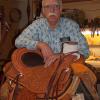-
Content Count
804 -
Joined
-
Last visited
About oltoot
-
Rank
Leatherworker
- Birthday 03/29/1943
Contact Methods
-
MSN
oldcoot1913@outlook.com
Profile Information
-
Gender
Male
-
Location
Wyoming
-
Interests
General horse related
LW Info
-
Leatherwork Specialty
Saddlemaker, retired now
-
Interested in learning about
tools, supplies
-
How did you find leatherworker.net?
link
Recent Profile Visitors
The recent visitors block is disabled and is not being shown to other users.
-

How can i sew flexible knee's and elbow joints?
oltoot replied to tjjLeather's topic in Leatherwork Conversation
It would require one of two things; first choice layout so that knee and elbow joints come from flank parts remembering that doing any leather project right means lotsa waste (a good shop layout includes a big scrapbox) and the next choice (worst) would be to include a v shaped gusset in your pattern, making the smaller insert piece from really light stuff. -

Looking for help making a Shriner Fez hat case
oltoot replied to FloridaLeatherCo's topic in How Do I Do That?
Look for the Al Stohlman book on how to make leather cases for the technique. I made a few in the early 2000's but I guess the pattern went to Missouri with the rest of them. I made a formed bottom to hold the shape, no center post. FYI, I'm glad the demand dried up. -
No, we set them up with a fan blowing on them and they thus dried pretty quick. No staining problems on rolls made of darker chap leather pieces. And we never let dyed shearling clippings get saved, only bark tanned shearlings that we used for saddle lining and relining. PS placing things in the path of a fan to dry proved useful for lotsa things.
-
My way: use shearling cilppings from trimming skirts. Soak in hot water, then stuff, fingers will do. when stuffed full, keep putting more in, squeezing out the water as you go. Surprising how easily you can compact wet wool. Then pull them down and let dry (it will take a long time) When they are getting dry, you can polish the edges and smooth out the welts. When in a hurry, buy the foam inserts. BTW, my way works with any shape.
-
Truck mud flaps
-

Old round punches - yard sale finds - need some TLC
oltoot replied to Sprocket's topic in Sharpen it!
be careful as too aggressive heats up the ends and you loose temper. Try taking sheets of sandpaper of varying grits on your marble slab and finish off with a gentle hand and a rolling motion. -
I think there was a pictorial in the first Al Stohlman saddle book with cased veg tan. The sash cord went through the cantle filler and cantle cover. They were first assembled cased and allowed to dry, then holes punched and binding fit, then removed, trimmed and replaced. (hint) pick translucent, not transparent rawhide piece
-
Silla means chair, seat andSADDLE in Spanish
-

Identify a saddle skirt with rings behind cantle
oltoot replied to EmilyRose's topic in Saddle and Tack Accessory Items
"Britchen Rings Can be just an option so that a saddle can be used (with Britchen) on a mule or 'mutton withered' horse without sliding forward. Sounds like a good idea but need to know that saddle otherwise fits before relying on Britchen. Good for a saddle that will sometimes be used as a pack saddle. Could be a good tool, along with a range of pads in using one saddle on a variety of equines. -

Pricing for Custom Saddle Tree Made by Kent Frecker
oltoot replied to Teddyi's topic in Leatherwork Conversation
Just sayin, to the general public and not to you---I generally refuse to make a saddle to "custom" dimensions, explained this way: a saddle has a fifty+ year life and a horse 20- so what are you going to do? Pads are much more flexible now so look to that as your short term solution for a misfit and pick a saddle to fit "general" types. -
Also bouncer or pounder
- 12 replies
-
- dividers
- brucejohnsonleather
-
(and 6 more)
Tagged with:
-

Vintage Fred Mueller High Back Saddle
oltoot replied to Cindee's topic in Saddle Identification, Restoration & Repair
If hardware is solid brass it is older if plated ,pre wwii if other metal, plated ww11 probably -
Ditto to all the cautions for elkhide. A good btw would be to note that bear hide woolies will hold up as I have actually put in quite a few hours of saddle time with a pair of them made on a self developed pattern for zippered woolies patched together with regular chap leather or easier to visualize the other way around, that is start with a pattern for zipper chaps and piece in the bear hide pieces on the outside with the chap leather next to horse. Seams are all vertical and this allows more flexibility in making hair alignment on bear hide to be vertical to shed water. One bear hide originally tanned for rug use will cut one pair of "hybrid" zipper shotguns. (note) the bear skin is really tough and can be shorn and shaved where it is to be joined with cow hide to make the joins smoother and smaller.
-
re belt widths: As far as I know (80 yrs old) To match a pant that said it had belt loops of 2" ,which were stitch line distance on belt loops so then -1/16 accounts for material thickness and would fit. IOW the thing which came first (in this case the pant) got to control the size issue. And I learned the craft in a saddle shop in Texas so no problems with metric system. Never used tools made outside US so never had to consider differences.

